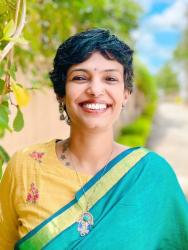Coming from a traditional patriarchal family, “you are a girl so…” has been the thread that wove my story, and this is still true for thousands of girls in India. Harmful gender norms are barriers to gender equality that negatively affect the lives and livelihoods of adolescent girls. As a 2013 study explains, the world shrinks for the girl as she is prepared for matrimony while the boys gain more freedom outside of the home as a preparation to become the breadwinner.
Coming of age – Cause for celebration or a curse?
“I was extremely stressed, as I did not know the reason behind menstruation. Whenever I tried talking about it, my mother and sister hushed me up. I only knew that when my friend started her periods, she never came back to school.”
– G. Kanya, a 14-year-old girl from a government residential school in Ghatkesar, Telangana, India (name changed for privacy)
India is home to 120 million adolescent girls, and for many of them, especially those from socioeconomically marginalized communities, puberty is a time rife with challenges including lack of formal education, early marriage, early pregnancy, little to no financial independence and hence lack of agency not just in their lives but those of their children as well. Lack of safe access to sex education, coupled with poor infrastructure for menstrual hygiene management, results in millions of girls leaving school. According to a 2023 UNESCO survey, 23 million girls drop out of school annually due to lack of proper menstrual hygiene management facilities, and 71% of adolescent girls in India remain unaware of menstruation till menarche. Once outside of school, these girls can very quickly disappear from formal structures and institutions. In preparation for marriage, they are often burdened with domestic chores and care work. Estimates suggest that each year, at least 1.5 million girls under 18 get married in India. Nearly 16% of girls aged 15-19 are currently married. This makes India home to the largest number of child brides in the world, accounting for a third of the global total.
Young brides in India often have little or no information on or access to family planning options and are also likely to become pregnant before their bodies and minds are ready to bear the responsibility. Studies show that 22% of all births in India are to mothers under 18 years of age.
As described above, many adolescent girls in India are stuck in what I call the “cycle of denial,” a vicious cycle in which their rights are denied at every stage of their development (Figure 1). This cycle perpetuates when adolescent girls become mothers. In India, 54% of adolescent girls are anemic, and every third child is underweight (32.1%) or stunted (35.5%). When adolescent girls give birth during childhood they have children who are more malnourished and anemic. Given their own supressed agency in the patriarchal set up, such young mothers often lack the ability to make choices for their children as well, which creates an intergenerational transfer of oppression.
Figure 1. The cycle of denial for adolescent girls in India

Source: Anusha Bharadwaj using illustrations from Voice 4 Girls
Can this cycle be broken? Voice 4 Girls (V4G), the organization I lead in India, has proven that it is possible. Since 2011, V4G’s programs have impacted the lives of a quarter of a million girls in India, many of whom have broken the cycleof denial and raised their voices against gender inequality. Through VOICE camps conducted in hundreds of schools across India, V4G has innovated on two fronts: (1) Creating safe spaces where adolescent girls gain knowledge and skills about sexual and reproductive health; learn about their rights related to school, home, and community; explore their careers, aspirations, and future planning; receive information about safety from violence and about their rights and responsibilities; and (2) providing mentoring by young college students who are the VOICE camp counselors. VOICE campers then become Sakhis, peer leaders in their schools and communities, where they further replicate VOICE’s ethos of “safe spaces.”
In 2021, V4G tracked 300 girls who had attended VOICE camps in 2015 and 2016 and who later became Sakhis. We found that 96% of girls were pursuing higher education, 2% were married but had negotiated with their in-laws to pursue education or set up small businesses, and the remaining 2% dropped out after grade 10 as they were unable to pass their exams. This is a resounding echo that the cycle can be broken.
In the words of Priyanka Toomukunta, a former VOICE camper from Telangana, India: “As students, we used to be very silent, but when we attended the camp, the space they provided us, the spirit they imbibed in us made us speak up more. If there is one thing that I can recall VOICE gave me, it would be the ability to SPEAK. It truly stands for its name, and I am a living example of it. I am not saying each and every one was able to speak, but to help raise even a single woman’s voice is a lot in itself, and VOICE did this to many women around me.”
During my time as a 2023 Echidna Global Scholar at Brookings, I will study what social and education ecosystem components help break the cycle of denial and create safe spaces for adolescent girls’ empowerment in India. I will assess the socio-cultural barriers that adolescent girls face and what knowledge and skills they need to break the cycle. With this information, I will develop evidence and insights for adolescent welfare policies that seek to ensure that all girls in India can break the cycle of denial and create lasting change in their lives.




Commentary
Powerful voices: How adolescent girls in India are breaking barriers and creating change
September 29, 2023